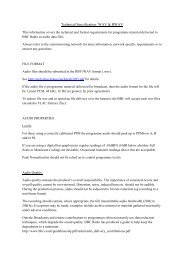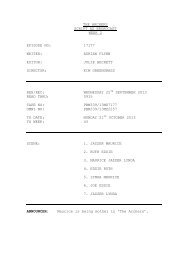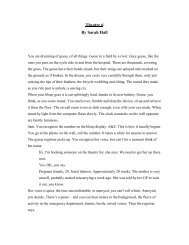50 Great British Inventions - BBC
50 Great British Inventions - BBC
50 Great British Inventions - BBC
You also want an ePaper? Increase the reach of your titles
YUMPU automatically turns print PDFs into web optimized ePapers that Google loves.
29 Military tank<br />
Invented 1914 Inventor ernest swInton<br />
In November 1914, the <strong>British</strong> Army was<br />
using crawler tractors to pull artillery on the<br />
Western Front, when Britain’s official war<br />
correspondent, Ernest Swinton, saw them in<br />
action and realised that they could perhaps be<br />
adapted into bullet-proof and power-driven<br />
offensive weapons that could storm the enemy<br />
lines and take out their guns.<br />
The idea was taken up and “landships” were<br />
developed: the “tank” description was meant<br />
to shield their true purpose from enemy spies.<br />
Because it was the Royal Navy rather than the<br />
Army that first developed them, naval terms<br />
28 Glider<br />
Invented 1804 Inventor george cayley<br />
One of the greatest inventors in the field of aviation<br />
was Yorkshireman George Cayley. The first-ever<br />
sustained manned glider flight was made in a craft<br />
of his design at Brompton Dale in 1853. (Cayley also<br />
invented the tension-spoked wheel – see page 17.)<br />
Cayley first designed an unmanned glider in 1804,<br />
and he was the first to move away from the idea that<br />
a man-made flying machine must have wings that<br />
flapped like a bird’s. Instead, he laid down the concept<br />
of a fixed-wing aircraft, subject to the forces of weight,<br />
lift, drag and thrust, for which he became known as the<br />
father of aeronautics. His first pilot is unknown, but it<br />
may have been his 12-year-old grandson, also George. <br />
were used for some of its parts, hence terms<br />
such as the “hatch” and “turret”.<br />
The first proper tank battle took place at<br />
Cambrai, France, in November 1917, when<br />
some 400 tanks penetrated almost seven miles<br />
behind the front lines, but they weren’t<br />
supported by infantry and soon had to retreat.<br />
These tanks had the capability to climb a<br />
five-foot obstacle, span a five-foot trench, were<br />
resistant to small arms fire and could travel<br />
at 4mph. Although the tank helped end the<br />
stalemate of trench warfare, it came too late to<br />
have much impact on the First World War. <br />
DID YOU KNOW?<br />
george cayley<br />
applied his<br />
genius to many<br />
fields. his ideas<br />
included<br />
an internal<br />
combustion<br />
engine that was<br />
powered by<br />
gunpowder.<br />
31 Jet engine<br />
Invented 1937 Inventor Frank whIttle<br />
Frank Whittle was a 24-year-old<br />
RAF fighter pilot in 1930 when he<br />
patented a new kind of aircraft<br />
engine – the turbojet.<br />
Whittle’s new design had<br />
no propeller and no pistons,<br />
using a gas turbine instead.<br />
With a rotating turbine and<br />
air compressor – and<br />
powered by thrust alone<br />
from the back – his new<br />
design was so radical that<br />
the military wouldn’t<br />
fund it, nor would any<br />
manufacturers.<br />
However, in 1937<br />
Whittle found a few<br />
private backers. After<br />
two more years of<br />
development, it was<br />
reliable enough for the<br />
Air Ministry, and on<br />
5 May 1941 at RAF<br />
Cranwell in Lincolnshire,<br />
a 17-minute test flight went<br />
ahead. It was a revolution. <br />
30 Modern torpedo<br />
Invented 1866 Inventor robert whItehead<br />
It was Giovanni Luppis, an officer in the army of the<br />
Austrian empire, who first came up with the idea of<br />
a self-propelled anti-ship weapon, but it was the <strong>British</strong><br />
engineer Robert Whitehead who really made Luppis’s<br />
concept work.<br />
Whitehead was working for the Austrian navy<br />
when Luppis met him and suggested his idea for a<br />
prototype “coast saver” that used a clockwork motor to<br />
traverse the surface of the water and that was steered by<br />
ropes from the land. Whitehead was captivated by the idea,<br />
though didn’t think much of Luppis’s designs.<br />
Over the next two years he came up with his own design<br />
for a “mineship” – a torpedo launched from a ship in an<br />
underwater tube, powered by compressed air and with an<br />
internal mechanism of his own invention that adjusted itself<br />
to stay at a constant depth. He presented it to the Austrian<br />
navy in 1866, improved the range, speed and accuracy and<br />
had a factory making and selling them worldwide.<br />
The first ship to be sunk by Whitehead’s invention was<br />
the Turkish steamer Intibah in 1878, after being hit by a<br />
torpedo launched from a Russian warship. <br />
14 00 RadioTimes <strong>50</strong> <strong>Great</strong> <strong>British</strong> <strong>Inventions</strong><br />
RadioTimes <strong>50</strong> <strong>Great</strong> <strong>British</strong> <strong>Inventions</strong><br />
15

















